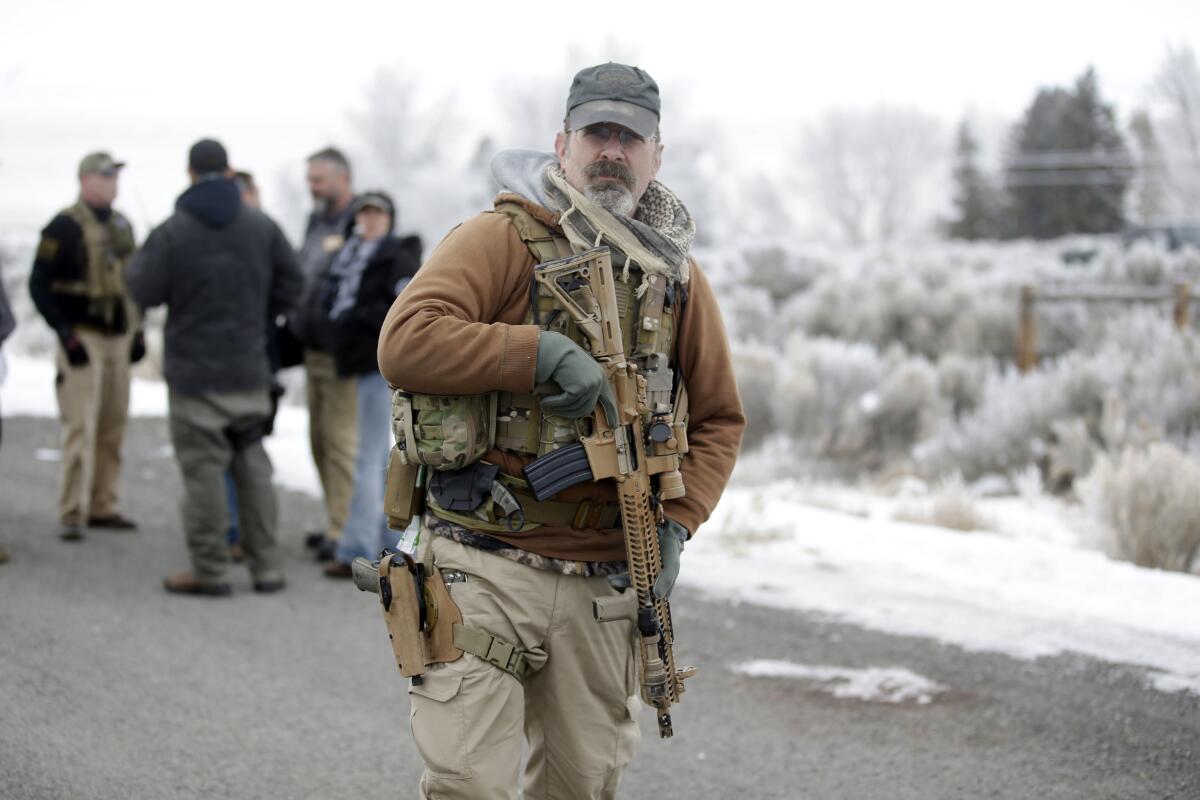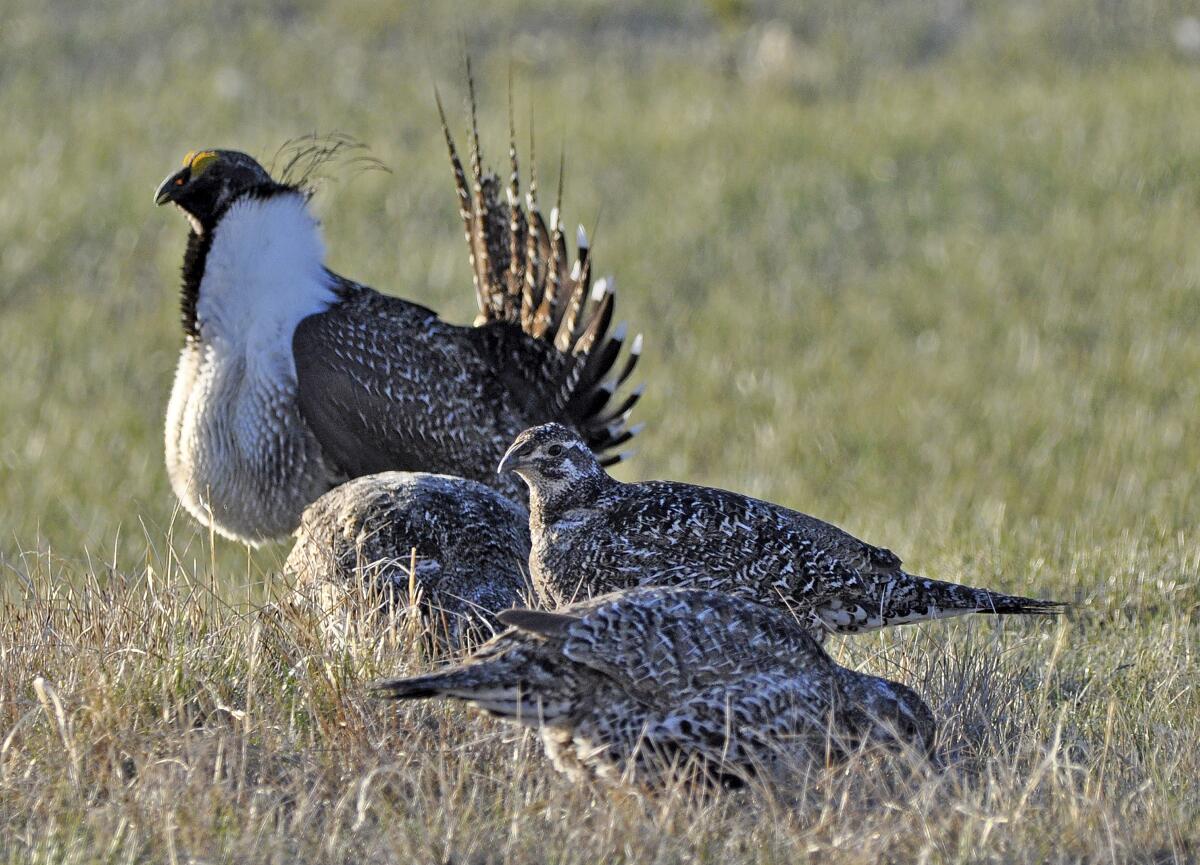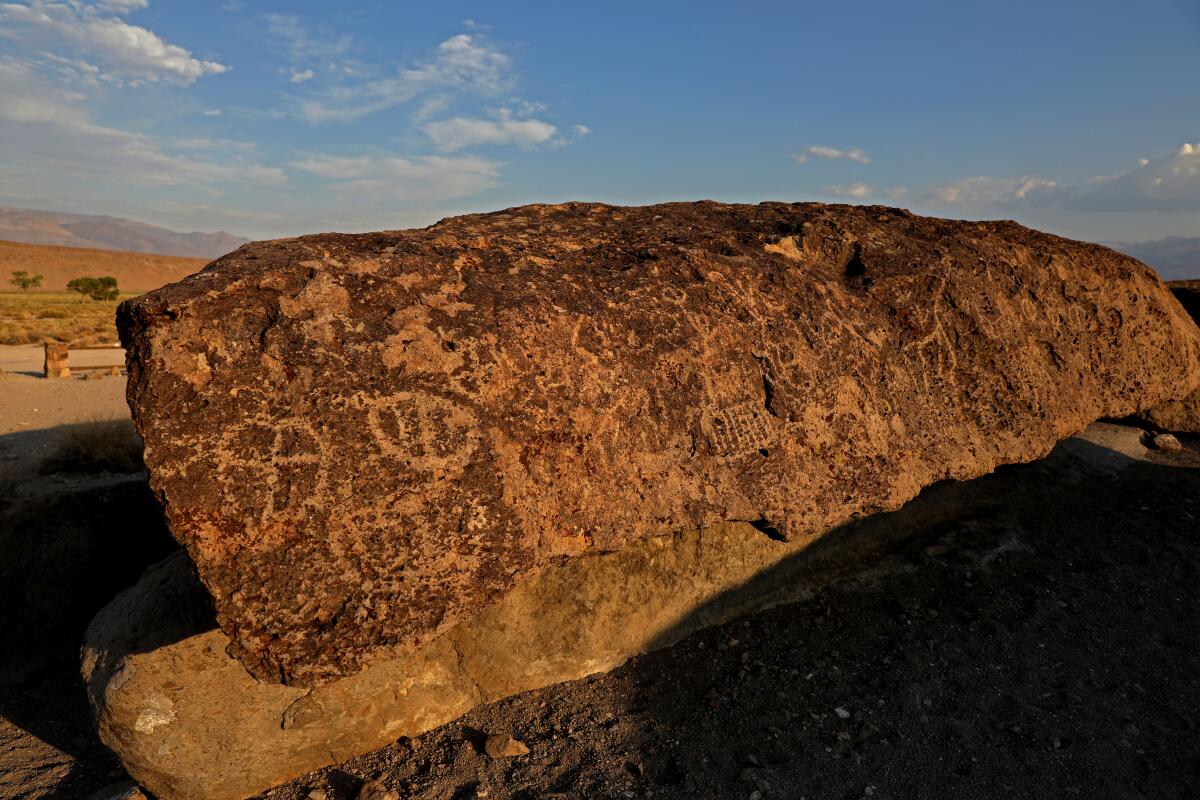Newsletter: Will drought and climate change feed more extremism in the West?

- Share via
This is the July 29, 2021, edition of Boiling Point, a weekly newsletter about climate change and the environment in California and the American West. Sign up here to get it in your inbox.
Good morning. I’m Stuart Leavenworth, editor of Boiling Point, filling in for the vacationing Sammy Roth. He will be back next week.
It’s sometimes thought that worsening wildfires, droughts and farming conditions — products of climate change — will lead to more conflicts and extremism, including in the West. Imagine a repeat of lawless mobs confronting and terrorizing federal land managers, as occurred at the Malheur National Wildlife Refuge in 2016, and could happen again amid the Klamath Basin water crisis, as The Times’ Anita Chabria has reported from the California-Oregon border.
Former Interior Secretary Sally Jewell doesn’t succumb to that gloomy theory. She sees opportunities for Westerners to overcome political differences and find common ground on their shared love for the land.
“Whether you are a far-right extremist or someone on the far left, nobody wants to see the habitat burn,” Jewell said in a recent interview with Chabria.

Jewell served as President Obama’s Interior secretary for nearly four years, from early 2013 to 2017. Before that, she served in top executive positions at REI, helping build the outdoor industry into a lobbying force to protect public lands — a counterpoint to “Sagebrush Rebellion” adherents who want states to take control of federal properties.
Less known is Jewell’s career path before she became the face of REI. Graduating with a mechanical engineering degree from the University of Washington in 1978, she took a job with Mobil, moved to Oklahoma with her husband, and worked there in the company’s oil and gas fields. She then spent nearly 20 years in the banking industry, during which she joined the REI board in 1996.
The Interior secretary job is often described as being the nation’s largest landlord, overseeing roughly 500 million acres. In that role, Jewell made a priority of expanding youth access to national parks and other open spaces. She also approved the first phase of the Desert Renewable Energy Conservation Plan, a contentious effort to balance desert conservation with the need to set aside vast expanse for clean energy projects, which Sammy has written about extensively.
Jewell’s background in industry gives her an empathy for people who work the land, and as Interior secretary, she was careful not to amp up the conflict between her department and rural Westerners. When followers of Ammon Bundy stormed the Malheur refuge and occupied it, carrying high-powered weapons, Jewell came under fire from the left for not quickly denouncing the armed action.
“Jewell ought to be the first person to stand up for these treasures when they come under attack. Instead, we got complete silence,” Matt Jenkins wrote in High Country News.
In her interview with The Times, Jewell made clear she saw Bundy and his hardcore followers as “domestic terrorists.” But she also argues their clout is waning as people view them as interlopers, trying to exploit federal policies for their own political gain. That’s a viewpoint that Chabria captured in her recent story, with The Times’ Hailey Branson-Potts, about Klamath farmers trying to find compromise in the region.
With the federal government coming under scrutiny for its response to this summer’s wildfires and farmers losing water supplies, it’s hard to imagine tensions in the West becoming cooler anytime soon. Still, the former Interior secretary is hopeful. Chabria’s interview with her has been edited for brevity and clarity:
CHABRIA: What do you see happening with land-use extremists as conditions on the ground become more intense?
JEWELL: What’s most interesting now is that climate change has the potential to bring people together around a shared concern. Let me give you an example — cheatgrass.

This is a very problematic invasive species, particularly in the Great Basin area, where it increases fire risk but also undermines grazing and undermines the sagebrush sea (the expanse of imperiled sagebrush across 11 Western states). That’s critical habitat for wildlife such the sage grouse, a threatened species, but also other wildlife that hunters rely upon.
For people who live on these landscapes and make a living from these landscapes, there is more common ground than is maybe popular to discuss.
CHABRIA: And yet tensions are building in many places. You had to deal with the Bundys during the standoff at Bunkerville, Nev., in 2014, and then the occupation of Malheur. Do you consider them as dangerous today as you did then?
JEWELL: I don’t think so. I think the Bundys and others got a bit of a scare with the way people showed up [at both Bunkerville and Malheur] with weapons. So it is an open question if they actually want to see that kind of violence, or see it as more of a business opportunity and an opportunity for visibility.
These are people who are exploiting problems, and the trouble with exploiting things is you don’t always remain in control. We saw that on Jan. 6.
CHABRIA: You’ve voiced frustration about the unsuccessful prosecutions of the Bundys and other defendants at Bunkerville and Malheur. Can you elaborate?
JEWELL: It does not feel to me like justice was served in either of those. In the case of Malheur, the laws were not very strong. If you have a showdown but someone doesn’t fire their weapon, the courts might see that as criminal trespassing but not conspiracy. So the consequences were not very significant. That is something Congress needs to examine.
CHABRIA: Given what happened on Jan. 6, why are you so optimistic there are opportunities for finding common ground?
JEWELL: I am hopeful that federal public servants, and also activist groups on both sides, will take this as an opportunity to come together, on water and other issues. Arguing and fighting over an increasingly scare resource is not going to serve anyone.
I can’t tell you how many people I met with and worked with on the question of listing the sage grouse under the Endangered Species Act, which we chose not to do, in part because of the deep collaboration across interests. I met with a lot of ranchers, who no question leaned much to the right, but they were not activist people. They just wanted to pass on their ranch and their life to their children and grandchildren.
If you recognize that, listen to their concerns, and also listen to those who are managing land and understand the science, you can come to a meeting of the minds.
CHABRIA: Can you give me an example from your time as secretary?
JEWELL: One of the reasons that the Malheur National Wildlife Refuge did not become more of a crisis was because Chad Karges, the refuge manager, had been working with a county judge in Harney County and ranchers and farmers in something they called the High Desert Partnership. They collaborated on how to actually improve wildlife habitat while improving farming practices.
The Fish and Wildlife Service could help farming by doing things like removing invasive species. And the farmers could help species by using flood irrigation, helping wetland habitat for birds as they flew through.
So you know, there’s been a lot of press and concerns about conflict, but I saw many, many instances where people actually worked together, and found points of common interest.

CHABRIA: And yet, as Interior secretary, you helped forge a compromise in the Klamath Basin to help resolve conflicts over water and wildlife, and it fell apart, leading to this year’s tensions. How do you feel about the standoff happening again there?
JEWELL: I’m frustrated. That agreement really called on people’s better angels, and the disputes that people are trying to exploit right now call on our dark sides. That is very, very unfortunate.
I am just hopeful that people will recognize that they will live a lot longer if they work together and collaborate than if everybody’s blood pressure goes up.
On that Boiling Point note, here’s what else is happening around the West:
TOP STORIES
It’s not yet August, but California has already recorded its 15th largest blaze ever — the Dixie fire — producing one of the more apocalyptic photos of the year. The image above was taken by Cal Fire Capt. Eric Limones, one of the people quoted in Hayley Smith’s dissection of how the fire in Plumas County became the state’s biggest to date, creating an enormous pyrocumulonimbus cloud and dangerous firefighting conditions.
A day later, the Dixie fire merged with another fire, as The Times’ Alex Wigglesworth reported, and by Tuesday monsoon conditions were adding to the state’s fire threats, as Smith and Lila Seidman detailed. Even bigger is the Bootleg fire in Oregon, which The Times’ Molly Hennessey-Fiske has been covering. Firefighters need aerial images to help track where such fires are spreading, but the Pentagon might let a little-known drone program called FireGuard expire, The Times’ Jennifer Habercorn and Anna M. Phillips report.
Climate change is helping to worsen conditions that lead to wildfire, and Amazon’s Jeff Bezos has worked to burnish his image by highlighting such threats. But the e-commerce platform he built continues to tout books that downplay or dismiss the threat of climate change, making it a vehicle for falsehoods, as Brian Contreras notes in an illuminating report for The Times.
Communications snafus prevented a quick emergency response and public warnings following a sewage spill that dumped 17 million gallons of waste into the Santa Monica Bay on July 11 and 12, according to a county report obtained by The Times’ Robert J. Lopez. Los Angeles County Supervisor Janice Hahn said that city officials, who run the Hyperion Water Reclamation Plant, have yet to sufficiently detail what happened, even as nearby residents continue to complain about noxious fumes from the facility, as my colleague Rachel Schnalzer reported.
DROUGHT AND HEAT
It’s hard to wrap one’s brain around the scale of this year’s drought, which stretches from British Columbia to Mexico, sandwiching a gigantic swath of the Western United States in between.
It’s a bone-dry sandwich. In California, the state is considering barring thousands of Central Valley farmers from drawing water directly from streams and rivers, as The Times’ Julia Wick reported, following on a report by the Sacramento Bee’s Dale Kasler. In Utah and Arizona, the mighty Lake Powell will soon hit its lowest level since 1963, when the federal government plugged the upper Colorado River with the controversial Glen Canyon Dam, as Brian Maffly reported for the Salt Lake Tribune.
In Washington state, the U.S. Drought Monitor has placed Spokane, for the first time, under the most extreme level of drought, Nico Portuondo tells us for the Spokesman-Review. Hoping to cool off by fly fishing in Montana? Better hurry up. The state’s famed trout fishery is in trouble due to low river levels and a crush of anglers, as Jim Robbins details for the New York Times. Baby salmon in California and other states are also dying, as Daisy Nguyen reports for the Associated Press.
ON OUR PUBLIC LANDS

A Caltech professor who drilled holes in an ancient petroglyph site while doing research without a permit has issued a public apology. The words of regret follow Louis Sahagun’s original report on the transgression for The Times and backlash from fellow scientists and Native Americans.
Leaders of a Colorado mountain town have extended “fundamental and inalienable rights” — like those conferred on people and corporations — to their surrounding 448-square-mile watershed. Expect there to be litigation, as Bruce Finley reports for the Denver Post.
THE ENERGY TRANSITION
Amid the heat, energy conservation is one way Californians can both reduce greenhouse gas emissions and help prevent power outages. But state residents seem to be increasingly weary of flex alerts, and less compliant in reducing energy usage, as Colby Bermel explores for Politico. California grid managers issued another flex alert for Wednesday, as The Times’ Matthew Ormseth reported.
Record heat. Raging fires. What are the solutions?
Get Boiling Point, our newsletter about climate change, the environment and building a more sustainable California.
You may occasionally receive promotional content from the Los Angeles Times.
California is spending billions of dollars to help people buy electric cars, but it can take months for them to get their rebates, and some may not get them at all, as Russ Mitchell of The Times’ reveals.
First cars, now battery-operated trains? Some Democrats in the state Assembly want the California bullet train board to explore that option. They are getting pushback from the Newsom administration and the state’s two U.S. senators, as The Times’ Ralph Vartabedian notes.
ONE MORE THING

Like a lot of Californians with pets, my colleague Susanne Rust has watched warily as coyotes have made their way into suburbs and cities, including her Menlo Park backyard. The incursions prompted her to make repeated fixes to her fence, but then, earlier this month, she had another scare.
Susanne was riding her bike when one of her sons contacted her with a photo of their dog, Kickapoo, its hindquarters red with an apparent wound. Remembering she had left a back door open for the dog before departing, Susanne feared the worst.
“I got home, and tried to inspect the wound, but Kickapoo wouldn’t let me get close,” Susanne wrote later in a post to friends. So she ushered the dog into the car and drove him to an emergency veterinary clinic. There a vet tech was ready to care for Kickapoo and told her they’d call in a few hours after doing a thorough examination.
“I drove home,” Susanne recalled, “fretful with worry.”
Thirty minutes later, the vet called her back, and asked if she had any red paint in her backyard.
“No,” Susanne responded, going into her backyard to check. To her surprise, there were no signs of a coyote attack — no blood or strewn tufts of dog hair — only a carpet of squished and half-eaten fruit under a bountiful plum tree.
“Could it be plums?” she asked the vet.
The line was was quiet for a moment, and then she heard some noticeable lip smacking.
“Yep. That’s it,” said the vet. “Definitely. Sticky and sweet.”
We’ll be back in your inbox next week with more plum content. If you enjoyed this newsletter, please consider forwarding it to your friends and colleagues.




